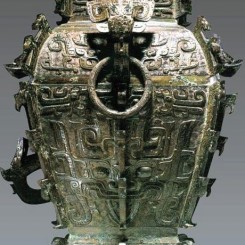On the evening of June 28th, a ceremony was held at the Hunan TV studios to commemorate the momentous occasion of reuniting a Shang Dynasty bronze “Minfanglei” wine vessel with its misplaced lid. The ancient artifact, a wine vessel dating from the Shang Dynasty (circa 1600–1046 BC), is also referred to as the “Mintianquan Fanglei”.
The vessel stands 84.8 cm in height with the lid on, and 63.6 cm without the lid. The entire vessel is patterned with leiwen (cloud patterns), along with masks, dragons, and birds in bold relief. A pair of ringed handles is mounted on the vessel’s shoulders, and the front of the vessel features a low-set pouring handle cast in the shape of a mystical beast head. The “Minfanglei” is the largest Shang and Zhou Dynasty vessel of this type that has ever been excavated, and is also called the “king of all fangleis” for this reason.
The “Minfanglei” was excavated in Taoyuan County, Hunan Province in 1919. Five years after the excavation, the body of the vessel was purchased by an antiques dealer, and its whereabouts was then lost overseas abroad. After changing hands several times, it materialized at a Christie’s New York auction in 2001. The vessel’s lid, however, remained in China, and has been housed in the Hunan Provincial Museum since 1956.
In March this year, the body of the vessel was once again delivered to Christie’s for auction, and through the collaboration of six enterprises in Hunan, the “Minfanglei” was successfully purchased through private sale to be “reunited” with its lid a century later.
The repatriation of cultural objects has been a controversial international subject. Parties involved may look to the Hague Convention (“Convention for the Protection of Cultural Property in the Event of Armed Conflict” adopted in 1954 at the Hague Convention) and the UNESCO issued “Convention on the Means of Prohibiting and Preventing the Illicit Import, Export and Transfer of Ownership of Cultural Property” (issued in 1970), but the crux of these controversies often sits at the dispute between universalism and nationalism, often rendering the process of repatriation fraught with difficulties.
Currently, the repatriation of Chinese cultural artifacts is mostly being driven by individuals or enterprises engaged in private purchases or donations. In 2002, China established “The Special Fund for Rescuing Lost Cultural Relics from Overseas”, which is the first non-profit organization based in the Mainland whose purpose is restoring lost cultural relics back to China; it also primarily operates through corporate donations.
